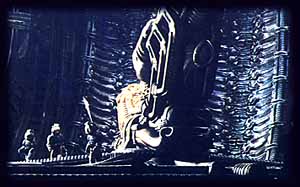|
|
 Sets and special effects evoke a strong sense of the uncanny in Alien.
|
Then, too, there are film scenes where
characters themselves are startled, but spectators are not. I
call these "mock threat scenes," where the viewer
watches a character teasingly feign a startle or attempt to
startle a nearby character, as in Jurassic Park (1984),
when Dr. Grant (Sam Neil) horrifies the young children he is
shepherding through the park by pretending to be shocked by a
massive electrified fence. In an earlier version from The
Haunting (1963), Luke (Russ Tamblyn) annoys his fellow
paranormal investigators during a spooky lull inside the old Hill
House by leaping, yelping in pain, and claiming a statue stepped
on his foot. Both films, of course, are notorious for startle
effects that do work. Then there are parodic threat
scenes/startle effects, as in Carl Reiner’s Fatal
Instinct (1993), a parody of classic film noir and big budget
Hollywood thrillers. Near the end of the film gumshoe Ned Ravine
(Armand Assante), alone in his big dark house, opens a bathroom
medicine cabinet--a black cat screeches and leaps out.
Contextualized amidst constant silliness, Fatal
Instinct’s cat-startle, itself formally
indistinguishable from effects which have startled
viewers, likely has yet to startle any viewer on this planet.
Lastly, a romantic comedy like Something to Talk About
(1995) fails to trigger spectator startles even though it
repeatedly depicts the two lead characters startling one another.
Although Julia Roberts and Dennis Quaid jump and scream loudly
when they surprise one another in various domestic encounters,
and the scene employs rapid editing, the lack of the full
complement of threat scene elements precludes actual spectator
startles.
Additionally, not all sincere attempts at
threat scene startle effects lead to startled spectators. Setting
aside the immense variables of individual psychology and context,
a few general response patterns seem to be at work. Along with
the tone of a scene or sequence, pacing appears crucial to
generating film startles. By "pacing" I refer to the
speed at which a threat scene develops, a factor contingent upon
rates of staging, camera and figure movement, editing. More
complexly, pacing also consists of what we might label the
viewer’s perceptual comprehension rate, the maximum rate at
which he or she may recognize objects, their locations,
trajectories, and velocities within real and simulated space.
Human cognition always involves a predictive element--startle is
often based on microsecond failings to anticipate the evolving
identity, location, and/or status of a stimulus in a threatening
context. We can tease out the significance of pacing to viewer
surprise and startle by conducting a brief thought experiment.
Let us take some infamously frightening threat scenes and potent
startle effects, say from Night of the Living Dead, Repulsion
(1965), and Suspiria (1977), and play them for
first-time viewers on a variable speed projector. It is quickly
apparent that the startle effects from all these films are
rendered impotent when sufficiently slowed. The results are even
more revealing: fear and disgust remain viable, if not amplified,
during the slowed presentation. Evidently scene pacing and
spectator comprehension rate impact viewer surprise/startle.
page 2 of 3
 
|


